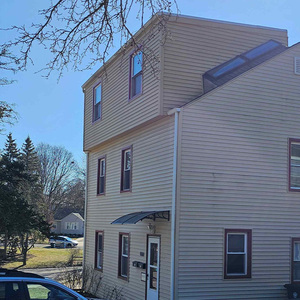I’m getting a new roof installed and would like some advice on these options that were presented in the contract: Ice and Water shield, 3 ft. or 6ft. from edge of gutter? This is a 4/12 hip roof with a 22 ft ridge, ridge vent or the individual metal roof vents,? Roof deck is 1×6 planks with minimal gaps between them, so 15# or 30# felt paper? Thanks very much for the input. -Ed
Discussion Forum
Discussion Forum
Up Next
Video Shorts
Featured Story

Keeping HVAC systems within the conditioned enclosure can be tough without a basement; one option is to use plenum trusses for the roof, which offer a space for equipment and ductwork.
Highlights
"I have learned so much thanks to the searchable articles on the FHB website. I can confidently say that I expect to be a life-long subscriber." - M.K.
Fine Homebuilding Magazine
- Home Group
- Antique Trader
- Arts & Crafts Homes
- Bank Note Reporter
- Cabin Life
- Cuisine at Home
- Fine Gardening
- Fine Woodworking
- Green Building Advisor
- Garden Gate
- Horticulture
- Keep Craft Alive
- Log Home Living
- Military Trader/Vehicles
- Numismatic News
- Numismaster
- Old Cars Weekly
- Old House Journal
- Period Homes
- Popular Woodworking
- Script
- ShopNotes
- Sports Collectors Digest
- Threads
- Timber Home Living
- Traditional Building
- Woodsmith
- World Coin News
- Writer's Digest


















Replies
Edd,
Where you live will impact those options. 3' of Grace might be fine in Penn. but not enough on the Upper Peninsula or Minn. or Maine.
Give us a little more info please for more help from the board.
Slateman, I'm 30 miles west of Chicago, IL. Thanks.
Edd,
Guys closer to you can give better advice than me from Maine-- but for the extra cost of a second course of Grace-- it would be worth it to me for peace of mind.
Ridge vent should be used if you have 22' of ridge and maybe several Lomanco passive vents on the sides with no ridge.
Either synthetic paper or 30 lb. would be my preference there.
I'm sure others will chime in soon.
Walter
Code in Michigan is Ice & Rain on the first 3' of conditioned space. Alot of guys screw that one up by not taking soffits into consideration. you really dont get a choice about that one (except for additional coverage).
I spec 30# paper.
EddJW
Around here (NW Iowa) we use 3' of Ice and Water as standard practice. In the Twin Cities code is 2' beyond exterior wall, which means for most cases that you would use 6'.
I have rarely seen ( in roof tear offs) sheathing damage or staining much above 12"F(from ice damming). Until this year. Alot of ice damming this year. We did one repair in the winter where the ice dam got the tar paper soaking wet about 4-5' up the roof.
Spent the extra money and go with 6'.
I would use the single over ridge vent. I have been installing it now for 6-8 years and I am very happy with it. Provides good air flow.
You didn't tell us how big your roof is so we have no way of knowing how much venting you need.
But you did tell us it is 1x6 planks so that would indicate that it is an older home 1940-1960 and it may not have good soffit venting, or there most certainly is not soffit chutes to transition the airflow from the soffit past the exterior wall/insulation junction.
Any roof vent (outgoing) is ineffective without another vent (soffit) to feed it.
In many cases there is no option of venting from below, but I install the ridge vent anyway because some vent is better than no vent.
I like the Duration shingles from Owens-Corning. They have a new nail strip of plastic that is almost impossible to blow your nails through. Pay extra and get the 40 year or the Lifetime. Maybe it's worth it maybe it's not. We'll find out in 20 years.
If you have valleys slateman and myself like open metal valleys with ice and water shield below. Just my preference.
To fill out your profile click on your name and a dialog box will appear. At the minumum you should give the approximate geographical region so others can help you.
Rich
Rich, the permitter of the house is 60x40 with a 2-ft. overhang with vented soffit. It was built in 1956.
EddJW
Look in the attic for soffit chutes. make sure there is air passage from the soffit to the attic.
Over that last 60 years ther is a good chance that it is blocked by insulation.
Rich
I would highly recommend the I&W 6 ft up from the gutter. Also you didn't mention if it was an option but the synthetic underlayments are the way to go. We use alot of Titanium UDL and Roofers Select. Both lay very flat and are impossible to tear. Go with the ridge vent as well, far superior to anything else......
Naive but refreshing !
Woody, I'm considering 2 bids, both seem to be very reputable contractors, pricing is very close but there are differences and that is the main reason for the advice.
Contractor #1 - specifies 15# felt paper and no ridge vent option, uses the single metal vents, gets specific on using 24-ga. Kynar 500 finished metal and the use of M1Urethane caulk for chimney flashing which he will gut a kerf in the mortar joints of the brick, Broan one way kitchen vent, lead plumbing stack boots. A 30 yr. GAF Timberline Prestique shingle with 6' of I&W shield, $3.00/ft. rotted wood replacement and a 10 yr. Labor warranty. This is a fairly large roofing company .
Contractor#2 - specifies 30# "underlayment", option on 3'or 6' I&W shield, option on ridge vent or single metal vents, aluminum flashing with mortar joints cut,does not specify caulk, aluminum dampered kitchen vent (no brand spec'd), metal valley liners, lead plumbing stack boots, $3.50/ft rotted wood replacement, 30 year Tamko shingle and 10 year Labor warranty. Very small company.
Sounds like ridge vent is most popular choice here, actually on Contractor#2's bid the ridge vent was less expensive than the single vents.
The method of installation on the ridge could result in an ineffective venting system. Verify the "free air space" with each product and installation technique that they are proposing. Bob's next test date: 12/10/07
Good ridge vents are preferred. On hip roofs you often need to use a combination of vent types to get proper ventilation. I gather that the roof is 60' long but you only have 22' of ridge. You really need at least 60' of ridge vent. One basic principal of roof venting is that at least 50% of the ventilation needs to be at the top - to get the "stack effect" going. The best solution might be 22' of ridge vent with 1 or 2 "pot vents" on the side roof planes. The disadvantage is that the pot vents are not very attractive but less noticeable if they are a similar color to the roof.
How is the roof vented at the top now?
Regarding the I&W shield, is there any problem with ice damning now? That shouldn't change assuming that your new roof is ventilated at least as good as it is now.
Matt, right now I just have pot vents installed. I know there is no I&W shield now and I sometimes see some ice sickles or drips from the soffit just a few inches up from the gutter. For $600 more, I guess it would be best to go with the extra 3' of I&W shield. I may need to ask the one contractor why he didn't recommend the ridge vent. When I look at the 2 bids there seems to be some differences, so I'm trying to figure which would be the best over all. The other thing that stands out a bit is that one recommends using painted aluminum and the other painted steel for the chimney flashing.
Tell them you want copper.It's a 40 yr. investment = pennies per day
Edited 3/16/2008 2:43 pm ET by Pelipeth
The width of I&W shield depends on the width of your overhangs. It needs to go 2' (I think that's the number) in from your walls -- at least that's code where I am. If you have no overhang, 1 row is enough. Otherwise, you may need to double up.
I'm usually happy with 15# under decent shingles. I'll use 30# if it's going to be exposed for a while and I'm depending on it for temporary waterproffing.
Mike Hennessy
Pittsburgh, PA
Unless it's required by code, Ice & Water Shield is necessary only if the attic heat loss and roof ventilation are so problematic that you have an ice dam problem. If no ice dams, there's no need for an extra membrane.
Over plank sheathing, definately go with the 30# felt. I would avoid the synthetic membranes since they don't breath like felt and can trap moisture below.
Since you have continous soffit vents, use a ridge vent but not just any ridge vent. The only ones that work effectively under all conditions are the ones with a wind baffle such as Lomanco or AirVent shingle-over ridge vents.
Solar & Super-Insulated Healthy Homes
Can't believe this. The advice is prety unanimous with a minor exception or two. Personally, I'd prefer Tamko shingles over GAF, but not enough to make a difference if you like the GAF contractor better.
OTOH, it's possible to get lost in the shuffle with a big contractor (you're just one of the jobs they're doing today). With the small company, you're their only concern today. For instance, a customer I was working with last week checked the BBB about my company and a large contractor that blew into town after a recent hail storm. In 10 years, I'd never had a complaint, but the large company had 3 against them already this month.
#30 felt or synthetic, 6' of I&WS, and ridgevent would be my usual answers without seeing any special concerns your project might raise.
edit: oh yeah, and copper.
http://grantlogan.net/
But you all knew that. I detailed it extensively in my blog.
Edited 3/16/2008 5:10 pm ET by seeyou
I got some really good info here as far as brand specific materials that you would use. I have to ask you guys, do you ever get a home owner asking you the exact brand of materials that you use such as ridge-vents, pot-vents, kitchen hood vents? I'm sure most people aren't concerned with what is being used but I just want to do this right. Thanks for all the replies.
If you know what you're talking about, you have a right to specify certain products in the request for bid - before, not after.
But most contractors will want to use what they're used to and may well turn down a job if the customer wants something different.
They DO have to warrantee their work, after all.
Riversong HouseWright
Design * * Build * * Renovate * * ConsultSolar & Super-Insulated Healthy Homes
I perfectly understand, I would never tell a contractor what materials to use. I would just like to know so I can do some research or run it buy the experts on this forum.
"If you know what you're talking about, you have a right to specify certain products in the request for bid - before, not after."Huh? Until the ink has dried, he always has the option of specifying. Bob's next test date: 12/10/07
Right - but if a HO tells me he wants his house framed with DF lumber (not generally available in this area) I'd start moving quickly away from the deal.... or at the very least it would add another week onto the bid process, not to mention the $$$. Speaking as someone who has hired roofers on many occasions, I only care about the brand of the shingle and the ridge vent.
Or how about this one - "I want all the nails in my home to be hand driven". Sure a HO can ask for whatever he wants but would that even be a smart thing to say?